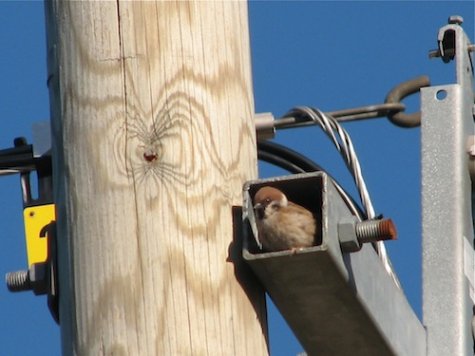Sparrows: power guards
Text: Eet Tuule and Aarne Tuule, Tallinna Linnuklubi
Photo: Aarne Tuule
Translation: Liis
Tree sparrow at its doorstep.
| Tree sparrow | Põldvarblane | Passer montanus |
The time most burdened with responsibility in a bird’s life is of course the nesting period. For the choice of a nesting place all species have during generations developed a feeling for their own typical sites where raising of the next generation should succeed. But there are always awkward nesters as well as smart ones. And those who have decided on really innovative solutions.
In Harjumaa county, on the lands of Saue and Saku parish, over the years white storks, buzzards, kestrels, collared doves, ravens and hooded crows have nested on the pylons of the high-voltage power lines. Soon after the opening of the electric railways the concrete columns of the railways were occupied by jackdaws and starlings. It seems that electric transmission lines have lately come to be used more and more by tree sparrows. This is because the number of small transformers grows steadily in the country. The high voltage power is transformed to low-voltage 400 V power in them at villages and single farms. In a couple of places the tree sparrows quickly found out that the hollow channel beams used in the construction of the transformer towers were absolutely splendid for their nests.
The number of house sparrows in the country is slowly decreasing while the tree sparrows increase. But nesting sites are ever fewer since in modern buildings there are not nearly such nest-building opportunities as there were around the old farmhouses. So no wonder that the innovative discovery of some sparrow pairs is utilised by their comrades. In our observation area at least it is easy to follow the spread of this exploitation of a new kind of nesting place. This year still more „on duty” sparrow electricians hop around the openings of their channel bar homes ...
But nests are built elsewhere too. Two or three tree sparrow couples have for instance moved into their yearly place in a white stork nest, in the outer layer of twigs.









